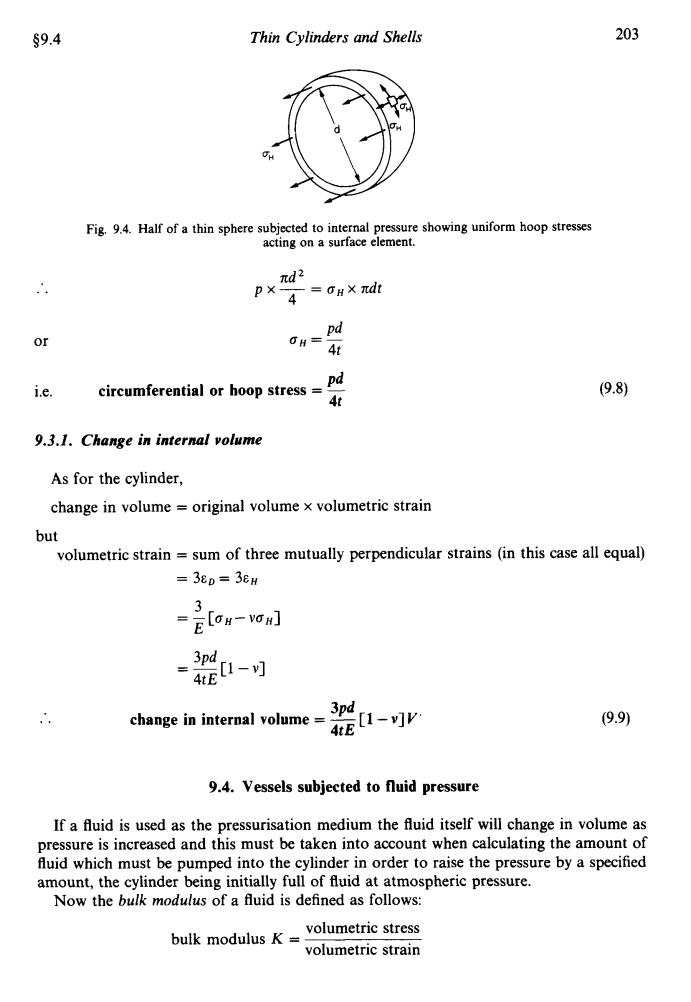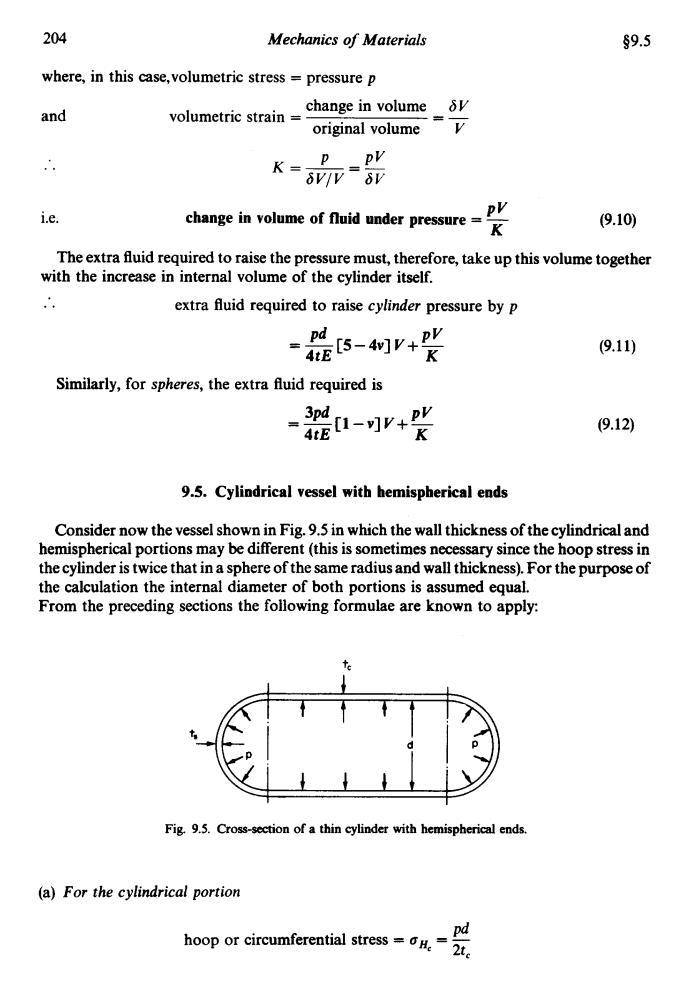
$9.4 Thin Cylinders and Shells 203 Fig.9.4.Half of a thin sphere subjected to internal pressure showing uniform hoop stresses acting on a surface element. nd2 px 4=0HXπd or 0H= Pd 4t pd i.e. circumferential or hoop stress (9.8) 4t 9.3.1.Change in internal volume As for the cylinder, change in volume original volume x volumetric strain but volumetric strain sum of three mutually perpendicular strains (in this case all equal) =38p=38H 3 =EoH-G小 -- change in internal volume= 3pd [1-v]v (9.9) 9.4.Vessels subjected to fluid pressure If a fluid is used as the pressurisation medium the fluid itself will change in volume as pressure is increased and this must be taken into account when calculating the amount of fluid which must be pumped into the cylinder in order to raise the pressure by a specified amount,the cylinder being initially full of fluid at atmospheric pressure. Now the bulk modulus of a fluid is defined as follows: bulk modulusK=volumetric stress volumetric strain
59.4 Thin Cylinders and Shells 203 .. or Fig. 9.4. Half of a thin sphere subjected to internal pressure showing uniform hoop stresses acting on a surface element. nd 4 p x - = CTH x ndt Pd bH=- 4t Pd circumferential or hoop stress = - 4t i.e. 9.3.1. Change in internal volume As for the cylinder, change in volume = original volume x volumetric strain but volumetric strain = sum of three mutually perpendicular strains (in this case all equal) = 3ED = 3EH .. 3Pd change in internal volume = - [ 1 - v] Y 4tE (9.9) 9.4. Vessels subjected to fluid pressure If a fluid is used as the pressurisation medium the fluid itself will change in volume as pressure is increased and this must be taken into account when calculating the amount of fluid which must be pumped into the cylinder in order to raise the pressure by a specified amount, the cylinder being initially full of fluid at atmospheric pressure. Now the bulk modulus of a fluid is defined as follows: volumetric stress volumetric strain bulk modulus K =

204 Mechanics of Materials s9.5 where,in this case,volumetric stress pressure p and volumetric strain change in volumeδV original volume p pV K-玩-影 i.e. change in volume of fluid under pressure= pV K (9.10) The extra fluid required to raise the pressure must,therefore,take up this volume together with the increase in internal volume of the cylinder itself. extra fluid required to raise cylinder pressure by p 证5-物+义 (9.11) Similarly,for spheres,the extra fluid required is [1-v]v+PY 3pd (9.12) 9.5.Cylindrical vessel with hemispherical ends Consider now the vessel shown in Fig.9.5 in which the wall thickness of the cylindrical and hemispherical portions may be different(this is sometimes necessary since the hoop stress in the cylinder is twice that in a sphere of the same radius and wall thickness).For the purpose of the calculation the internal diameter of both portions is assumed equal. From the preceding sections the following formulae are known to apply: Fig.9.5.Cross-section of a thin cylinder with hemispherical ends. (a)For the cylindrical portion pd hoop or circumferential stresst
204 Mechanics of Materials 59.5 where, in this case,volumetric stress = pressure p and volumetric strain = - change in volume 6V original volume Y -_ (9.10) PV i.e. change in volume of fluid under pressure = - K The extra fluid required to raise the pressure must, therefore, take up this volume together with the increase in internal volume of the cylinder itself. .. extra fluid required to raise cylinder pressure by p = -[5-4v] Pd v+- PV 4tE K Similarly, for spheres, the extra fluid required is = ~ 3Pd [l - v] v+ PV - 4tE K (9.1 1) (9.12) 9.5. Cylindrical vessel with hemispherical ends Consider now the vessel shown in Fig. 9.5 in which the wall thickness of the cylindrical and hemispherical portions may be different (this is sometimes necessary since the hoop stress in the cylinder is twice that in a sphere of the same radius and wall thickness). For the purpose of the calculation the internal diameter of both portions is assumed equal. From the preceding sections the following formulae are known to apply: I c 1 I t t t I I I I 1 I Fig. 9.5. Cross-section of a thin cylinder with hemispherical ends. (a) For the cylindrical portion Pd 2tc hoop or circumferential stress = bHc = -